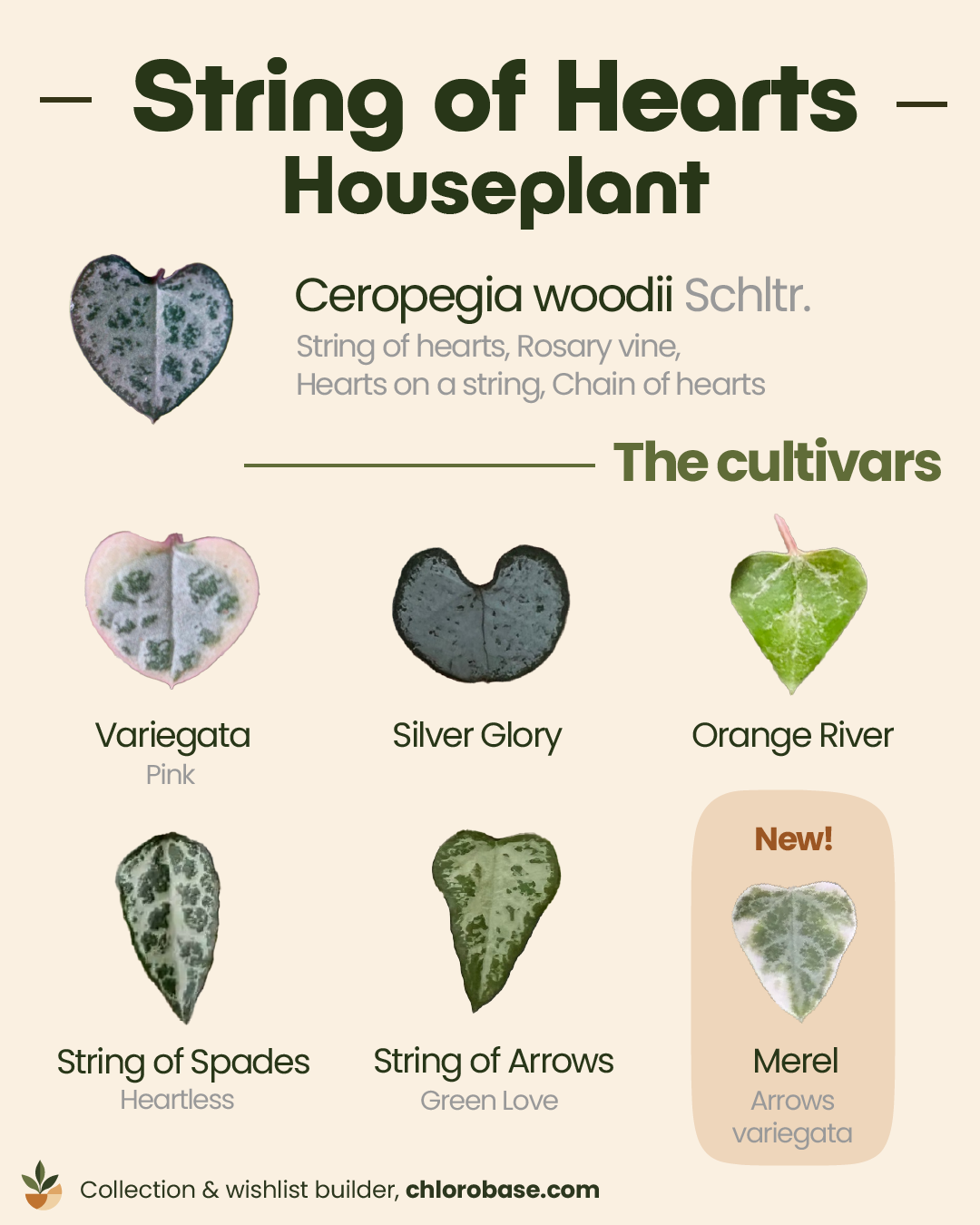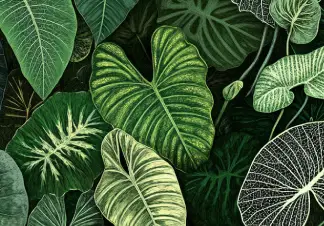Diving into all the varieties of String of Hearts
Hey plant friends, Anthony here from Chlorobase! Ever find yourself scrolling through plant photos, thinking you've seen it all, and then stumbling upon a variation of a familiar favorite that just makes you stop? That happens to me all the time, especially with plants that seem simple at first glance. Take the classic String of Hearts, for instance. We all know and love it, but have you ever really explored just how much variety exists within this single species?
The plant we commonly call String of Hearts is scientifically known as Ceropegia woodii. It's a staple for many of us, dangling gracefully from shelves and windowsills. But the world of SoH goes far beyond the standard green and silver hearts. Nature (and clever cultivation) has given us a fantastic array of cultivars, each with its own unique charm. Today, I want to take you on a little tour of these variations, showcasing the subtle and not-so-subtle differences that make collecting them so rewarding. Prepare to meet the extended family!
Small disclaimer: This article will only cover the string of heart varieties. We will cover the cousins like String of Turtles or String of Pearls another day!
The beloved original: Ceropegia woodii
Before we dive into the cultivars, let's appreciate the parent plant that started it all.

ceropegia woodii
-
Description:
The standard specie is instantly recognizable by its slender, wire-like vines adorned with pairs of small, succulent, heart-shaped leaves. These leaves typically have a lovely deep green base colour overlaid with intricate silver-grey marbling or veining on the top surface, often with a purplish underside. The delicate stems cascade downwards, sometimes producing fascinating little tubers along their length.
-
General Care Mention:
It's generally considered quite forgiving, often tagged as 'easy care', which definitely adds to its appeal. It thrives on a bit of neglect when it comes to watering, thanks to its succulent nature.
-
Origin & Popularity:
Native to South Africa, Swaziland, and Zimbabwe,
Ceropegia woodii
was first described in the late 19th century. It quickly captured hearts (pun intended!) worldwide and remains incredibly popular in households and among collectors for its delicate beauty and trailing habit.
Spot the differences with our visual chart
With so many variations popping up, telling them apart can sometimes feel tricky. To help with that, we've put together a visual guide that highlights the key differences in leaf shape, colour, and patterns at a glance. It’s a great quick reference when you're trying to identify a specific String of Hearts type.

You can share this chart freely, but please keep our branding and tag us on social networks!
Meet the Ceropegia woodii collection
Alright, let's get acquainted with some of the standout varieties. I find it fascinating how small tweaks in genetics can result in such different looks.
String of Arrows - Pointed foliage

ceropegia woodii 'string of arrows'
Instead of the classic rounded heart, this cultivar features leaves that are more elongated and pointed at the tip, resembling little arrowheads or narrow triangles. The colouration is often a rich green with distinct silvery veining, similar to the standard type, but the shape gives it a sharper, more defined look. It's sometimes also known as 'Green Love'.
Silver Glory - Frosted beans appearance

ceropegia woodii 'silver glory'
If you love the silvery tones of the original, 'Silver Glory' takes it up a notch. The leaves are almost entirely washed in a beautiful matte silver, with just a thin margin of green around the edge. The leaf shape tends to be a bit rounder, sometimes almost kidney-shaped, and often slightly larger than the standard woodii. It has a very soft, ethereal look.
This variety and the classic String of Hearts are sometimes very similar, especially if you give it a lot of light. Is it only marketing? Maybe, or maybe not.
'Variegata' - Pink & cream edges

ceropegia woodii 'variegata'
This is perhaps the most popular variegated form, often simply called 'Variegated String of Hearts' or 'Pink String of Hearts'. Alongside the typical green and silver, the leaves display beautiful splashes of cream and pink, particularly around the margins. The stems are often deep pink or purple, and the intensity of the pink hues can really pop when the plant gets plenty of bright, indirect light. It's a real showstopper.
'String of Spades' - Elongated leaves

ceropegia 'string of spades'
Similar to 'String of Arrows' in having a non-traditional heart shape, 'String of Spades' (also known as 'Heartless', 'String of Dagger', or 'Mini Star') has leaves that are more spade-shaped – narrower and more pointed, but perhaps less triangular than 'Arrows'. The foliage is typically a bright green with lighter green mottling, and the stems tend to stay lighter, often lacking the strong purple tones seen in other varieties. Some suggest it might be a hybrid involving Ceropegia linearis.
'Orange River' - Warm blushing stems

ceropegia woodii 'orange river'
Named after a region in South Africa, this variety often shows more triangular or arrow-shaped leaves, similar to 'String of Arrows', but they can be slightly larger. Its standout feature is the tendency for the stems and sometimes the leaf edges to develop a distinct orange or reddish blush, especially under high light conditions, adding a warm contrast to the green foliage.
'Remy' - Solid green leaves

ceropegia woodii 'remy'
This new patented cultivar stands out for its simplicity. 'Remy' features small, heart-to-triangular-shaped leaves that are a uniform, solid green colour, lacking the characteristic silver marbling of the species. It originated as a stable mutation from 'Green Love' (which is often used as a name for 'String of Arrows'), offering a clean, lush green look.
'Merel' - Triangular but with variegation

ceropegia woodii 'merel'
Another interesting patented mutation, 'Merel' presents small, somewhat triangular leaves. The centres are green, often with greyish-green tones along the veins, but the most striking feature is the very prominent, broad white or cream margin around each leaf. The leaf shape gives a distinctly different variegated pattern compared to the 'Variegata' cultivar.
How to care for the various String of Hearts
Good news! Despite their visual differences, the care for most Ceropegia woodii varieties is quite consistent and generally follows the needs of the parent species.
-
Light:
Bright, indirect light is key. Too little light, and the vines might become 'leggy' with larger gaps between the leaves. Too much direct sun can scorch the delicate leaves. An east-facing window or a spot slightly back from a south or west window is often ideal.
-
Watering:
This is crucial – they are succulents! Allow the soil to dry out significantly between waterings. Check the soil moisture or gently squeeze the leaves near the base – if they feel firm, wait; if they feel a bit soft, it's likely time to water. Overwatering is the most common issue, leading to root rot. Water less in winter when growth slows.
-
Soil:
A well-draining mix is essential. A standard cactus/succulent potting mix works perfectly. You can even amend regular potting soil with extra perlite or coarse sand.
-
Pot:
Ensure the pot has drainage holes. They don't mind being slightly root-bound.
A Note on Variations: While general care is similar, remember that heavily variegated types like Variegata or Merel might appreciate slightly brighter light to maintain their colours and may grow a bit slower due to having less chlorophyll. Always observe your specific plant! For more detailed care on each one, just click through to their individual pages here on Chlorobase.
So many hearts (and spades, and arrows...) to love!
Isn't it amazing how much diversity can come from one humble species? From subtle shifts in leaf shape to bold splashes of colour, the Ceropegia woodii family truly offers something for every taste. Whether you stick with the classic or decide to hunt down some of the more unique cultivars, they all bring that delicate, trailing charm to our indoor gardens.
Exploring these varieties is part of the fun of being a plant parent. As your collection grows, you can keep track of which ones you have and which ones are still on your 'must-find' list by creating your account here on Chlorobase for free! It makes it super easy to organize – maybe give it a try!
Which String of Hearts variety is your favorite? Don't hesitate to click on any of the plants above to explore their specific pages for more photos and details.
Until next time, happy growing!
Anthony
